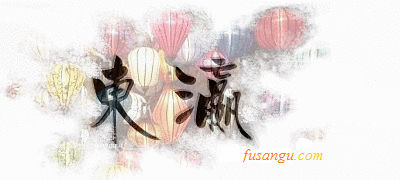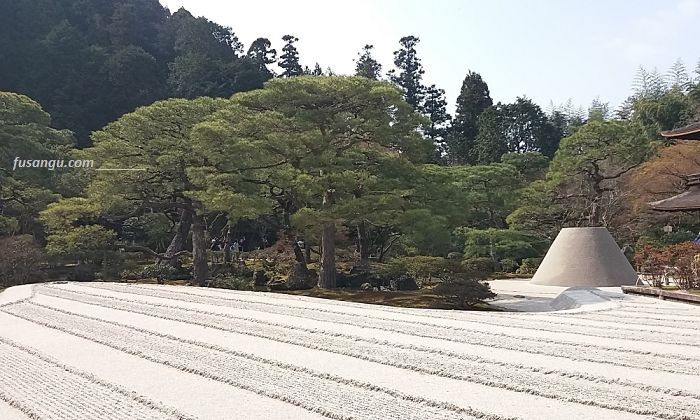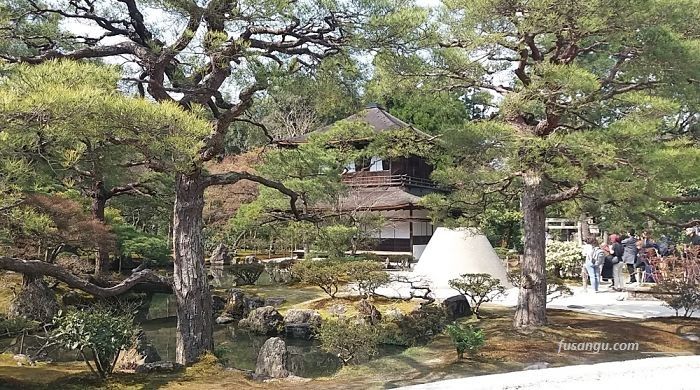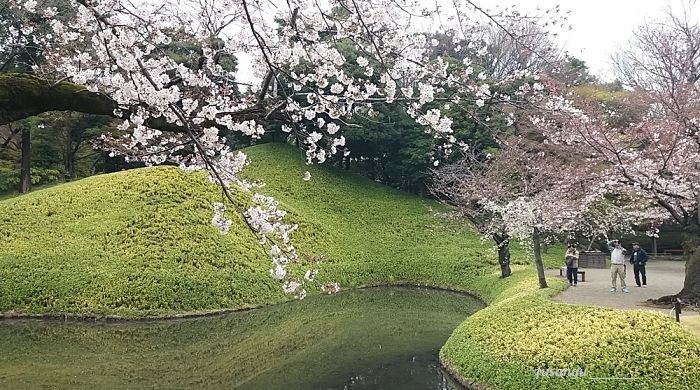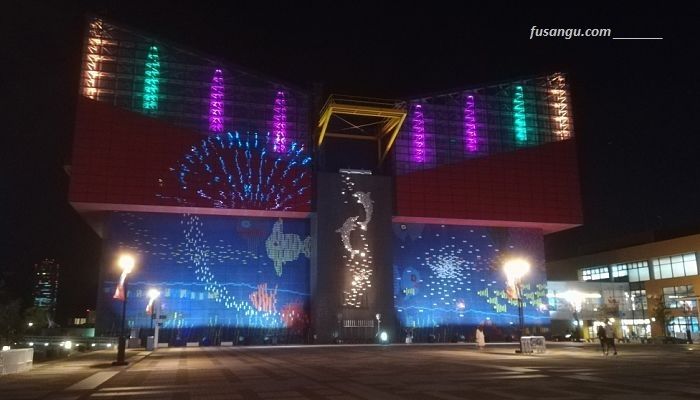
In this page we describe a sightseeing programme suitable for a 2-day visit to Osaka. While the city is rich in sightseeing places and offers plenty of opportunities for a pleasant travel experience, Osaka is often visited with a hasty one-day tour.
The article is intended to help those who have never visited Osaka before and want to organise everything on their own.
Osaka 2-day itinerary: suggested programme
The programme described below aims to offer a travel experience as wide as possible. As the time available is very limited, it is important to organise the journey in a rational way. This can be accomplished by choosing a hotel in a convenient position.
Day 1 – Osaka city centre
A day can be spent in Osaka in many different ways. Here we describe a programme that strikes a balance between traditional sightseeing and exploring the ordinary city.
Umeda
Umeda is a neighbourhood in Kita, the northern centre of Osaka. In the vicinity of Osaka Station is a sprawl of high-rise buildings, steel and glass towers, shopping malls and department stores (Yodobashi Camera, Daimaru, Isetan, only to mention a few). These are among the most popular in the country and there is a certain value in this modern architecture.
Amid all this amount of concrete, steel and glass and their coldness, lies an ancient modest and graceful shrine. The stories linked to it are hearth-warming. It is Tsuyu-no-Ten-Jinja.
If you like walking reach Tenjinbashi, Japan’s longest shopping arcade.
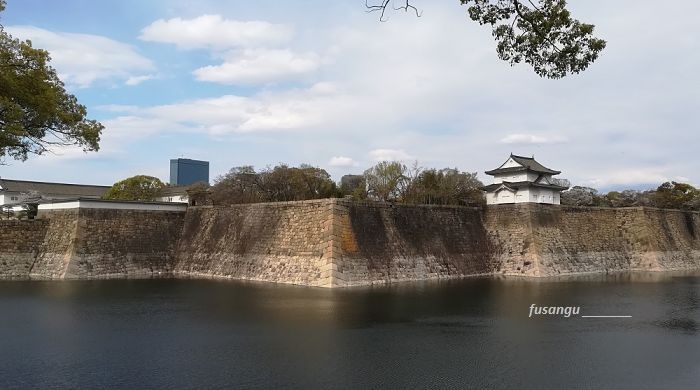
Osaka Castle, Museum of History
Symbol of the city, Osaka Castle is a large military architecture surrounded by a large park and a complex systems of tall walls and vast moats. Most impressive are the huge megalithic walls. Some stones are so large that up to now it is not clear how they were moved and taken to the site.
Though beautiful, the castle is a post-war reconstruction. The work did not make use of the original structural design. Inside the main structure is a museum.
The park is amazing, especially in autumn and spring. Nishinomaru garden lies in the area.
At the south-western corner is Osaka Museum of History.
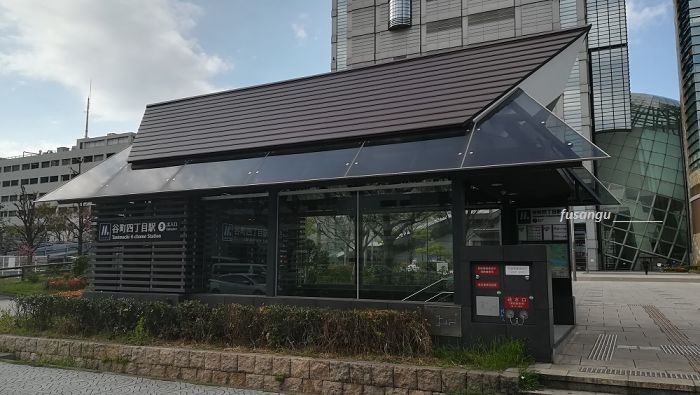
Kaiyukan
Kaiyukan is a large aquarium displaying a large variety of marine wildlife. The visit route proceeds from the top to the bottom of the building. As you move downward you periodically see the huge central tank where the biggest inhabitants live. Among them whale sharks.
The aquarium features a detailed description of environments lying along the Ring of Fire.
Oniric music accompanies the visit with a relaxing effect perfectly matching your humbling enjoyment of the might of mother Nature.
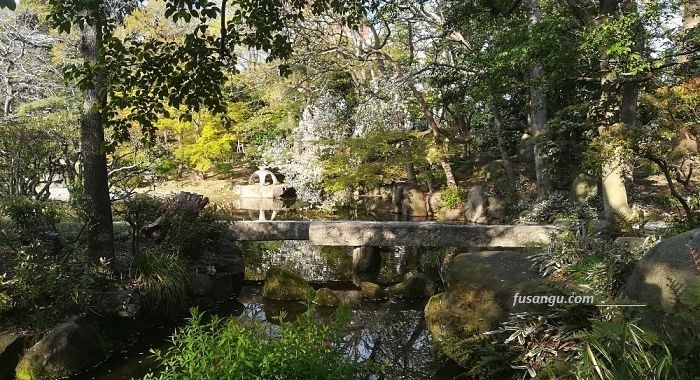
Day 2 – Southern Osaka
The second day is spent in the southern part of the city. Alternatively you may opt for a side trip, even a half-day one. Interesting destinations near Osaka are Himeji and Kobe.
Tennoji
Near Tennoji Station are a few sightseeing spots. Most notable are the Museum of Fine Arts and beautiful Keitaku-En garden. Above the station is the huge Abeno Harukas skyscraper. The view from the top across the bay is fantastic.
A historical temple, Shitenno-Ji, is a few hundreds of metres away. It does not look as impressive as other temples you have visited by now but its historical significance is notable.
Sumiyoshi Taisha
If you choose to end your journey with an image of traditional Japan, visit Sumiyoshi Taisha, a large shinto shrine in the southern periphery of Osaka. You can reach it by train from Osaka Station. The Sumiyoshi Station lies within walking distance of the shrine.
Kishiwada
Between Osaka and Kansai Airport, conveniently served by the passing railway lines, is Kishiwada, a small town where you can visit a small but beautiful castle. The site is a popular cherry blossom sightseeing spot.
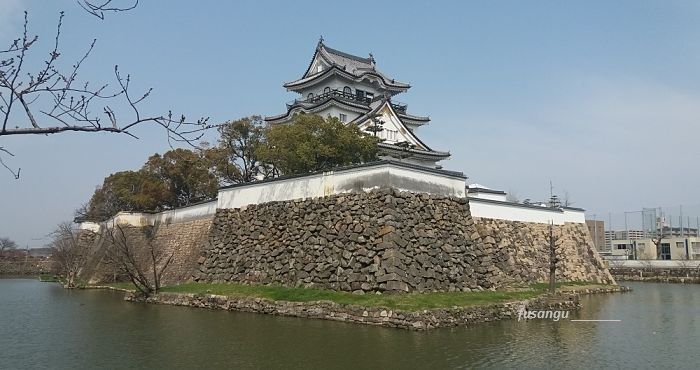
In the evening
After you are done with the sightseeing, head to Dotombori (near Namba) and plunge into the chaos, colours, sounds and allurements of Osaka’s nightlife scene.
Where to stay in Osaka
If you choose to stay in Osaka, we recommend that you choose an accessible area. The best neighbourhood is Namba, in the southern centre of the city, close to the night life scene, well served by public transport and with a huge range of hostels and hotels.
If you travel on a high budget you can also consider the area close to Osaka Castle or Umeda.
This programme is ideally part of our recommended Japan 10-day itinerary.
Related articles:
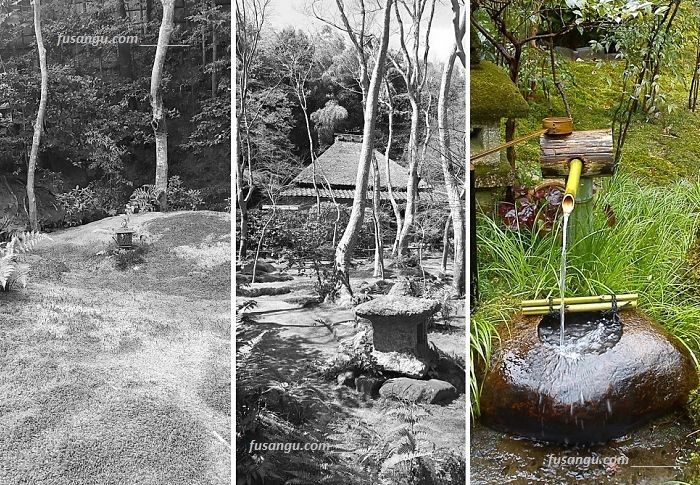
If you are specifically looking for a two and a half-day Kyoto itinerary, this means you are most likely pressed for time and you would like to make the most of every second of your stay. Keeping this in mind, in this page we present an itinerary that we believe can satisfy your needs. The programme minimises transfers and difficulties in planning all aspects of your stay without sacrificing the enjoyment of the experience.
-
Two and a half days in Kyoto (how to allocate the available time; suggested places to visit)
-
Evening arrival (suggested itinerary)
-
Morning arrival (suggested itinerary)
-
Where to stay (best locations)
Kyoto 2.5-day itinerary
A two-day itinerary in Kyoto usually revolves around Higashiyama and two or three major temples in other areas of the city, such as Fushimi, Kita or Sakyo. Higashiyama deserves at least one full day. Besides, spending a half-day in Higashiyama would be quite impractical, as you would not be able to enjoy long walks in the district, which are a not to be missed experience. Given this assumption, we have to choose where to spend another full-day.
We believe you should choose Arashiyama, a historical scenic site where natural and cultural landscape coexist in perfect harmony. Similarly to what happens with Higashiyama, visiting Arashiyama requires at least one-full day. Not doing so would greatly limit your freedom.
The remaining half-day can be spent to visit either Kinkaku-Ji and Ryoan-Ji temples or Fushimi Inari Taisha, a wonderful shinto shrine. The latter is always open and very atmospheric at dawn or sunset, which makes it an ideal choice for the half-day available. The shrine is very close to Kyoto Station, which makes it a perfect destination if you are planning to leave Kyoto around noon. Conversely, if you are to reach Kyoto around noon, in choosing what to see you should take into account that most temples, shrines, museums close around 17:00 (or 16:30 in winter).
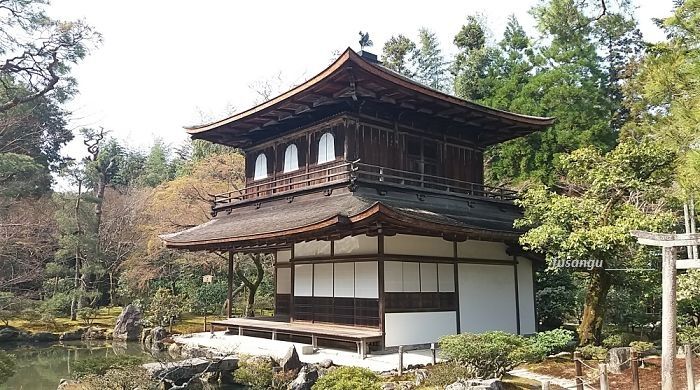
Evening arrival itineraries
If you reach Kyoto in the evening, you can reach your hotel, check in and spend some hours taking a walk around Gion or Ponto-cho, some of Kyoto’s most atmospheric areas at night.
|
Evening arrival in Kyoto Higashiyama, Ukyo, Fushimi |
|
|
Where to stay |
Kyoto Station area |
|
Day 1 |
Destinations: Higashiyama (Kiyomizu-dera, Sannen-zaka, Ninen-zaka, Yasaka-no-To, Maruyama Park), Philosopher’s Path, Ginkaku-Ji
How to get around:
|
|
Day 2 |
Destinations: Arashiyama (Togetsu-Kyo Bridge, Tenryu-Ji, Sagano Bamboo Grove, Jojakko-Ji, Rakushisha, Gio-Ji, Daikaku-Ji)
Optional visit to Nijo Castle: you can add a visit to Nijo Castle along the transfer from Kyoto Station to Arashiyama. If you choose to do so, you will have to cancel at least 2 visits in Arashiyama
How to get around:
or
|
|
Day 3 (morning) |
Destination: Fushimi Inari Taisha
How to get around:
|
Morning arrival itineraries
If you reach Kyoto by noon, we suggest you leave your baggage at the station and begin your journey right away.
|
Morning arrival in Kyoto Higashiyama, Ukyo, Fushimi |
|
|
Where to stay |
Kyoto Station area or Gion (Higashiyama) |
|
Day 1 Afternoon |
Destinations: Fushimi Inari Taisha and another destination
Additional destination:
How to get around:
|
|
Day 2 |
Destinations: Kinkaku-Ji, Ginkaku-Ji, Maruyama Park, Ninen-zaka, Sannen-zaka, Kiyomizu-dera
Optional visit to Gion: instead of Kiyomizu-dera temple you may choose to visit Kodai-Ji and Chion-In, interesting temples located near Gion
How to get around:
|
|
Day 3 |
Destination: Arashiyama (Togetsu-Kyo Bridge, Tenryu-Ji, Sagano Bamboo Grove, Jojakko-Ji, Rakushisha, Gio-Ji, Daikaku-Ji)
How to get around:
|
Visit to Uji
Another option, particularly suitable to those who wish to visit Nara, is to devote the half day for an excursion to Uji, historic town served by the Kyoto-Nara railway line. Uji is home to important temples and shrines and offers a unique atmosphere of serenity and attachment to tradition.
Where to stay
As mentioned, an aspect you should consider carefully when you accept the idea of such a short stay in Kyoto is how to properly choose the area where to find the accommodation.
For such a short stay we suggested considering only two options:
-
Kyoto Station area (Shimogyo and Minami);
-
Gion area (including nearby Nakagyo district).
Staying in these areas will allow you fast and easy transfers, which is a fundamental need for such a short journey.
As you might have noticed, our recommendation on where to stay depended on the visiting programme.
We also suggest that you reach Kyoto the night before the first day of visit, so as to avoid any loss of precious time.
Related articles:
Kyoto 3 day itinerary | Kyoto 3,5-day itinerary
Ideally this programme is part of a 10 to 12-day journey between Tokyo and Kyoto. See: Japan 10-day itinerary.
Nearby destinations:
Nara 1,5-day itinerary | Uji 0,5-day itinerary
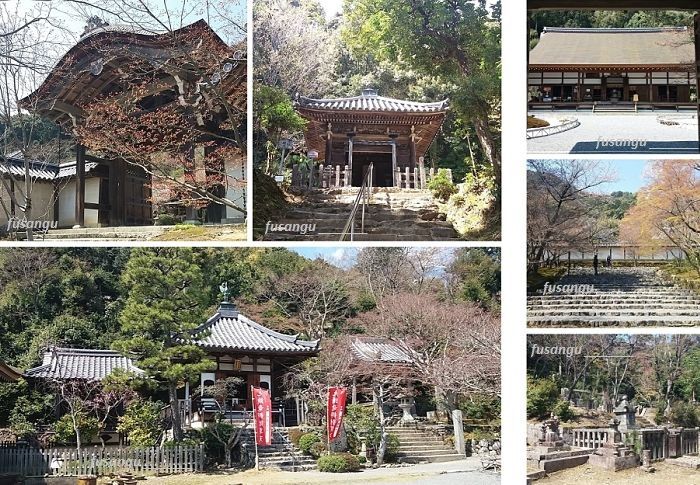
A three-day visit allows to see a small but significant part of Kyoto’s most important sightseeing places.
Being the duration of the journey very limited, there is not much room for improvisation and a careful planning is required in order to minimise the time absorbed by transfers.
Considering the relatively limited options of getting around in a fast and easy way, a good strategy is to devote each day to a very limited area of the city and make appropriate choices on where to find accommodation.
In this page we provide detailed information and suggestions on how to spend three days in Kyoto. Possible half-day excursions to nearby travel destinations are also presented. Final remarks help define possible adjustments and variations based on the season.
The itinerary and its variants are centred on the must-see places, those exceptionally beautiful religious and historical sites which have shaped the image and the identity of the ancient capital and elevated it to the status of symbol and cultural core of traditional Japan.
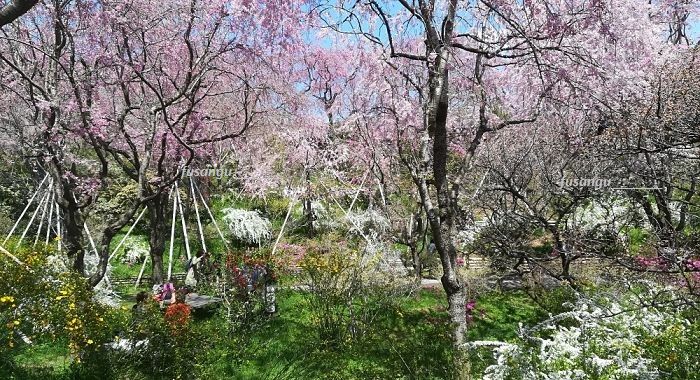
As three days are a very limited time frame to visit Kyoto, a good choice to spend one day in Higashiyama, one day in Kita and its surroundings (either Kamigyo or Ukyo) and one day in Arashiyama. The magnificient Fushimi Inari shrine can be easily visited at the end of the second or third day.
Said itinerary is particularly recommended to those who travel in Japan for the first time.
Being time very limited, we suggest you visit the mundane centre during the evening. In many ways this choice proves to be the right one, as you will easily ascertain later.
Contents
-
First visit to Kyoto (sightseeing places, things to do in a 3-day stay)
-
Suggested itinerary (programme, detailed description of the journey, possible variations)
First visit to Kyoto: must-see places, things to do
Despite being one of the few Japanese cities which were not annihilated during the last year of World War II, the centre of Kyoto is quite dull and uninteresting and very little remains of its historical architecture.
The vast majority of the city’s cultural treasures and sightseeing spots are found in peripheral districts and the surroundings.
Higashiyama, situated to the east of the centre, is the area where you can enjoy the atmosphere and beauty of the ancient city. A good amount of traditional houses, tea houses, temples along picturesque narrow alleys can be found here. They offer plenty of occasions for relaxing and inspiring strolls, especially if your imagination can actively complement your observations.
Gion, the so-called geisha district, is the core of this area and in many ways the place where you will want to start and finish your visits (possibly at dawn and dusk, where tranquillity and silence will make you feel and see what you would never perceive in daylight and in the midst of crowds).
Along with Higashiyama, you should not miss neighbouring Sakyo, to the north, where many of Kyoto’s most beautiful and culturally significant shrines and temples lie amid forested and scarcely populated hills.
A typical first time visit to Kyoto encompasses the beautiful Kinkaku-Ji (the Golden Pavilion), the enchanting Fushimi Inari Taisha, amazing shinto shrine set in a mysterious forest on a sacred hill, and Arashiyama, an astonishing cultural landscape, where human intervention seems to have reached perfection in its reverent dialogue with nature.
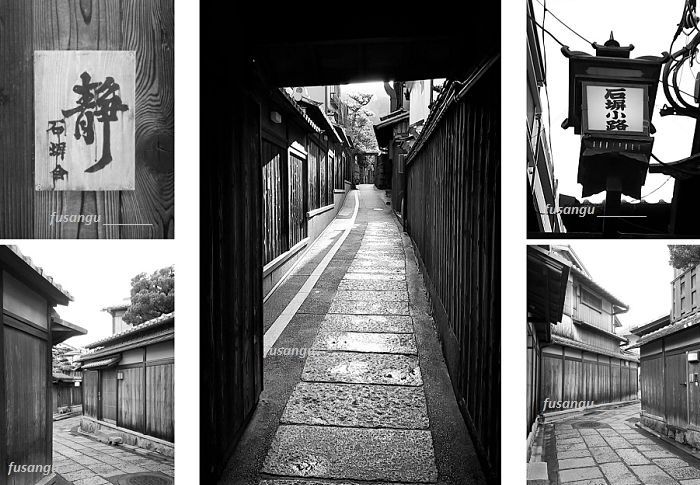
Itinerary: Higashiyama, Kita, Fushimi Inari Taisha, Arashiyama
This itinerary is a good introduction to ancient Kyoto. The pace is not too fast as to make the experience enjoyable and allow for some improvisation.
Visits should commence no later than 8:00 (possibly by 7:00 during high season, especially during cherry blossom and autumn leaf periods).
The programme is most suitable for those who stay near Kyoto Station, Higashiyama (Gion). These are in our opinion the best places to find accommodation for such a short stay.
Day 1: Sakyo and Higashiyama
Higashiyama (“eastern hills”) is a large district where urban density is low and small and old houses are often surrounded by forests and parks. Together with neighbouring Sakyo, this is Kyoto's major trove of cultural treasures, a place that has exerted an indelible influence on Japan's cultural and spiritual development.
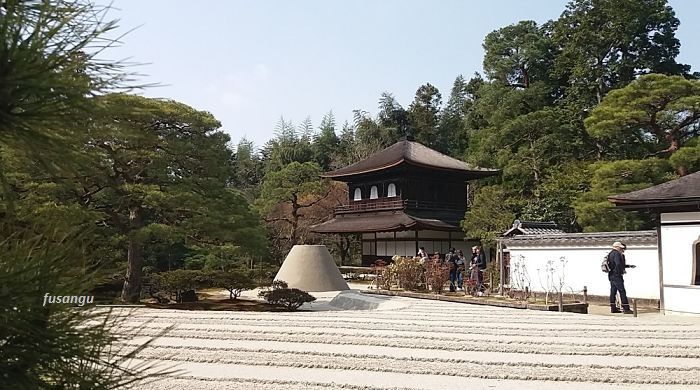
8:30-9:30: Ginkaku-Ji
The journey ought to begin from the renowned Ginkaku-Ji (literally “Silver Pavilion”). A shogun, Ashigaka Yoshimasa, made his villa a gathering venue for philosophers, monks, artists. This villa was later converted into a Buddhist temple.
The place is considered the cradle of the illustrious Culture of Higashiyama, which had a profound and lasting influence on the flourishing of arts such as tea ceremony and design of landscape gardens.
The temple comprises a number of ancient buildings centred around a dry garden. The Silver Pavilion, Kannon-den, houses a statue of Kannon, Bodhisattva of Mercy. It did not get the decorative finishing its name refers to but this does not detract from the extraordinary finesse of its architecture.
Lush vegetation meticulously taken care of, a small moss garden and a tiny bamboo grove are encountered as you move along the circular visiting path. Rising above the temple, the trail allows for a commanding view over Sakyo.
9:30-11:00: Philosopher’s path
A few hundreds of metres separate the entrance of Ginkaku-Ji from the famous Philosopher’s path.
This is a small trail running from north to south along a small canal. Small houses, most of which are not particularly beautiful but retain the scale and feel of the old architecture are to be seen to the right; to the left you will find a few alleys leading into small neighbourhoods and secluded temples.
Making for a pleasant stroll at any time of the year, the trail is a must-see attraction during the cherry blossom when the prevailing someiyoshino cherries form amazing tunnels of white flowers. The enchanting view is made even more beautiful by the singularity of a few rarer weeping cherries, whose vivid pink flowers gently stand out.
Along the path you may want to pay a visit to the Honen-In.
Without hurrying too much you will likely get to the Eikan-Do Zenrin-Ji by 11:00. This is another Buddhist temple, particularly popular when the maples turn red (which usually occurs during the second half of November).
11:00-12:30: lunch break
Having lunch early is a good way of avoiding tedious queues at restaurants. This is particularly important during the cherry blossom, where you will likely encounter large crowds.
12:30-13:30: Chion-In
The Chion-In is one of Kyoto’s largest and most popular Buddhist temples. Head of the Jodo school, the compound comprises several buildings and gardens set in the slope of a hill.
Amid an amazing natural setting are some of the finest examples of the ancient capital’s sacred architecture.
The imposing Sanmon, the largest wooden gate in Japan, leads to a large flight of stairs. The steep ascent is rewarded by a commanding view of the area.
Artistic, ancient and deeply revered statues are housed in the main halls. Yuzen-En, a modern garden located near the Sanmon, is particularly beautiful in autumn.
13:30-14:30: Maruyama Park, Yasaka Shrine
Continuing southward you enter Maruyama Koen. This is a large and beautiful park, most visited in early spring. The festive atmosphere during cherry blossom is an attraction on its own. The most beautiful tree, a large weeping cherry blossom, glows in pink usually at the end of March.
Nearby is Yasaka-Jinja, one of the most popular shinto shrines of Kyoto.
14:30-15:30: Kodai-Ji
A few hundreds of metres separate Yasaka-Jinja and Kodai-Ji. This is one of Kyoto’s most beautiful zen temples. Enchanting in the autumn colours (lit in the evening in late November), the temple comprises buildings of worship, a garden, tea houses, a bamboo grove. The composition and its single elements amount to a real masterpiece.
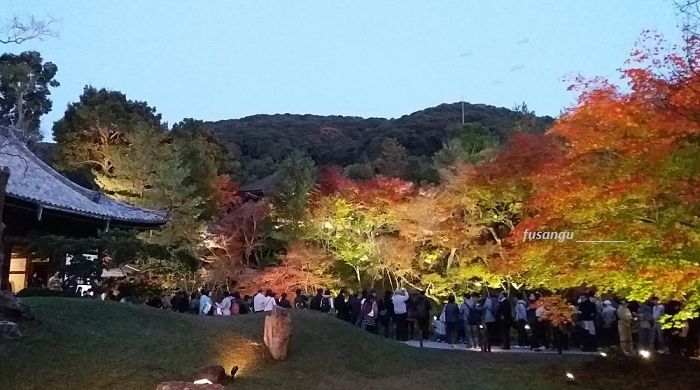
15:30-16:30: Ichinen-zaka, Ninen-zaka, Sannen-zaka, Gonen-zaka
There is not enough time to wander around Gion and that is best done in the evening (or at dawn if you choose to stay here) when there it is not crowded.
Once you are done with the visit to Kodai-Ji, find the Daidokoro-zaka alley and turn left into Nene-no-michi. This is the beginning of a fascinating itinerary along picturesque alleys (Ichinen-zaka, Ninen-zaka, Sannen-zaka, Gonen-zaka), pleasant sights. Do not miss out on Yasaka-no-to Pagoda.
16:30-17:30: Kiyomizu-dera
The final destination is Kiyomizu-dera (“Pure Water Temple”), a magnificent Buddhist temple atop a small hill surrounded by woods.
Its architecture is unique. A terrace connected to the main hall allows beautiful views over cherry and maple trees. In the right season, the feast of colours is a wonderful sight.
Make sure you visit nearby Jishu Shrine, dedicated to the deity of love, and Otowa Waterfall, whose waters are said to bestow conjugal happiness, success in the studies and longevity. Expecting mothers visit Koyasu Pagoda. From its grounds you get a view of the whole temple.
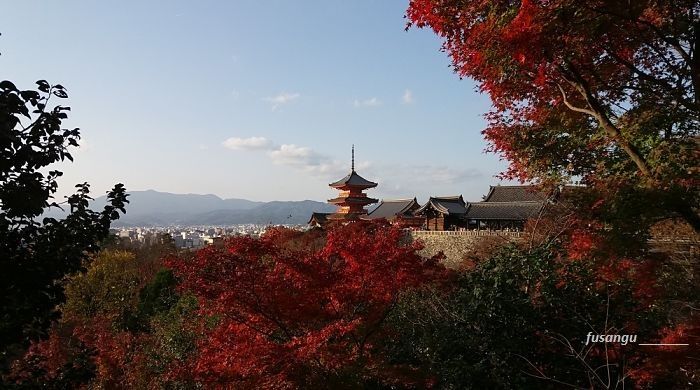
Day 2: Arashiyama and Nijo Castle
On the second day it is possible to reach all destinations by train from Kyoto Station. If you choose to stay in the centre or Higashiyama, you can simply reach the station by bus or subway.
This is an intense programme and depending on your attitude toward travel you might want to reduce the number of sightseeing places.
Arashiyama, already a tourist destination during Heian Period, is an amazing natural and cultural landscape located in the western periphery of the city. You can reach it by train (JR Sagano line) from Kyoto Station in less than half an hour.
7:30-8:30: Togetsu-Kyo, Hozu River
Again, we suggest you start your sightseeing very early, especially in high season. Once you have reach Saga-Arashiyama Station walk westward through the quaint little town. Eventually you will find the river and the recognisable Togetsu-Kyo, a beautiful bridge crossing over Katsura River. The scenery all around is most beautiful in spring and autumn but there is a subtle charm to it during winter.
8:30-9:15: Tenryu-Ji
Not far from the bridge is Tenryu-Ji, an ancient Buddhist temple of great cultural significance. While most buildings you can see now are reconstructions, the wonderful garden is in its original form. You can see a wide variety of plants, many of them are labelled.
Follow the paths around the garden and allow yourself some time to contemplate the serene beauty of the scenery.
After reaching the Taihoden (whose exquisite roof in the irimoya-zukuri style shows the sublime influence exerted by Tang China on Japanese sacred architecture), walk northward and exit the grounds of the temple.
9:15-10:00: Bamboo Grove and Kemayama Park (or Okochi Sanso Villa)
A left turn and you are in the famous bamboo grove, one of the most iconic scenes of Kyoto. At the end of the atmospheric trail is decision time. If you turn left you can reach Kemayama Park (very nice in spring). If you turn right you can visit Okochi Sanso Villa.
As time is limited you may decide to skip both and continue walking northwards.
10:00-12:30: Jojakko-Ji, Rakushisha, Gio-Ji
Going past Ogura Pond, a tiny building with a thatched roof appears across a field. Its name is Rakushisha, the “Hut of Fallen Persimmons”. Simple, small, modest, you do not need to know Japanese literature to realise that this was the hermitage of a haiku poet.
After visiting the little gem move westward and reach Jojakko-Ji, a Budddhist temple nestled on the western side of Mount Kokura. Its small buildings are little jewels. The pagoda is classified as Important Cultural Property. The scenery in the autumn tones is enchanting.
Proceeding northward you encounter another little treasure. Gio-Ji is a tiny temple nestled amid large trees. The deep shade and vivid colours of the moss garden surrounding the temple create an atmosphere of mystery. Gio-Ji originated at the retreat of a woman who lost the favour of her lover. She was then joined by her mother and sister.
12:30-14:30: Daikaku-Ji or Adashino Nembutsu-Ji and Otagi Nembutsu-Ji
After having lunch you can either visit Daikaku-Ji or, if you enjoy walking, continue walking till Otagi Nembutsu-Ji.
Options:
-
Adashino Nembutsu-Ji and Otagi Nembutsu-Ji: ancient Buddhist temples with distinctive features and a sense of history and seclusion. Along the way you can see many traditional buildings;
-
Daikaku-Ji: founded on the site of a former imperial residence, it is a large Buddhist temple with many buildings in different architectural styles. It lies close to a pond which was modelled after Lake DongTing. DongTingHu is a mythical scenery which inspired countless works of art. It lies between HuNan and HuBei (the two provinces derive their name from their position relative to the lake).
14:30-15:00: From Arashiyama to Nijo Castle
After going back to Kyoto Station, you can take a train bound for Nara. Make sure it stops at Inari Station.
15:00-16:30: Nijo Castle
Nijo-Jo was the residence of the Tokugawa shogun in Kyoto. The elegant architecture displays the power and prestige of the dynasty. Surrounded by a moat and walls with keeps, the grounds are accessed through imposing and richly decorated gates.
With relatively small-scale fortifications, the structures are organised along two circles of defence. Very little remains of the honmaru, the inner circle. Within the ninomaru are the buildings open to visitors. They are among the best examples of this kind of architecture and comprise masterpieces of Japanese art.
Of particularly outstanding artistic value are the fusuma (Japanese sliding doors), the ceilings and the painted screens of the main chamber.
The visit takes you through a number of waiting and audience rooms, connected by a long corridor built with the characteristic “nightingale floors”, which, as a security measure, emit a squeak-like sound when stepped upon.
Inside the castle are gardens and groves of plum and cherry trees. These include relatively rare varieties of plants.
Variants
You can postpone the visit to Nijo Castle to the next day and choose to visit Kyoto’s Railway Museum and Fushimi Inari Shrine.

Day 3: Kita, Ukyo and Fushimi Inari Taisha
The third and last day is devoted to Kita, Ukyo and Fushimi Inari Taisha. All destinations can be easily reached by bus from Kyoto Station, the centre or Higashiyama.
The programme is not too intense and gives plenty of margin for other activities, such as further visits in the areas we have already mentioned or simply a final walk in the centre.
9:00-10:00: Kinkaku-Ji
Kinkaku-Ji (“Golden Pavilion”, formally Rokuon-Ji), is an iconic Buddhist temple located in Kita, on the north-western periphery of Kyoto, near the range of mountains that marks the northern limits of the urban sprawl.
The elegant three-story shariden reflecting in the water of the large Kyokochi pond surrounded by pines and small rocks, is one of the most iconic images of Kyoto and all Japan. It serves as the storehouse of sacred relics.
The walls of its upper structure are covered in gold leaf. Each floor is built in a distinct architectural style. The lavish work of art reflects the taste in vogue during the Kitayama Culture.
The building served as the retirement complex of the shogun. It has been destroyed and rebuilt several times throughout history, the last time in 1950 when a monk burned it down. The event was recounted by Yukio Mishima.
10:00-10:30: From Kinkaku-Ji to Ryoan-Ji
You can reach Ryoan-Ji on foot (in 20 minutes) or by bus (number 59) or taxi in less than 10 minutes.
10:30-11:30: Ryoan-Ji
Formerly an aristocratic villa, Ryoan-Ji was converted into a Zen Buddhist temple. Its hiraniwa (garden without hills or ponds) quickly rose to popularity.
The dry garden features fifteen rocks laid on white gravel. They seem to be drifting in a sea. From whatever angle you view the garden, you will not be able to see all of the rocks.
The mysterious nature of this creation does not come as a surprise as Ryoan-Ji is affiliated to the Rinzai Zen Buddhism, a school that emphasises the importance of solving koan (riddles meant to encourage going beyond the limits of rational thinking) as a privileged way to attain enlightenment.
After pondering and meditating, you can visit the grounds of the temple, which comprise a large pond garden. Most likely you will then return to the rock garden for a final contemplation.
11:30-14:00: Lunch break; transfer to Kyoto Station and then Inari Station
You can have lunch at the tofu restaurant inside Ryoan-Ji or near or inside Kyoto Station. You can reach the station by bus (59 and 101)
Some trains bound for Nara stop at Inari Station, from which you can walk to your next destination, Fushimi Inari Shrine.
14:00-17:00: Fushimi Inari Taisha
A long avenue leads to the entrance of Fushimi Inari Taisha. This is most important shrine in the nation dedicated to the shinto deity of rice.
The gentle ascent along the wide sando inspires a sense of solemnity. At its end the imposing gate. Its majesty is softened by the vibrant vermilion coating.
This colour is employed in almost every building of the site, from the main halls to the more modest auxiliary gates.
After seeing the halls in the lower part of the shrine, the main worship are, go through the impressive sequence of torii which lead deep into the forest. You cannot help but feel the mystic sense of this experience. At the top of the mount are smaller shrines and burial mounds.
Early morning and sunset are the best time for visiting this shrine.
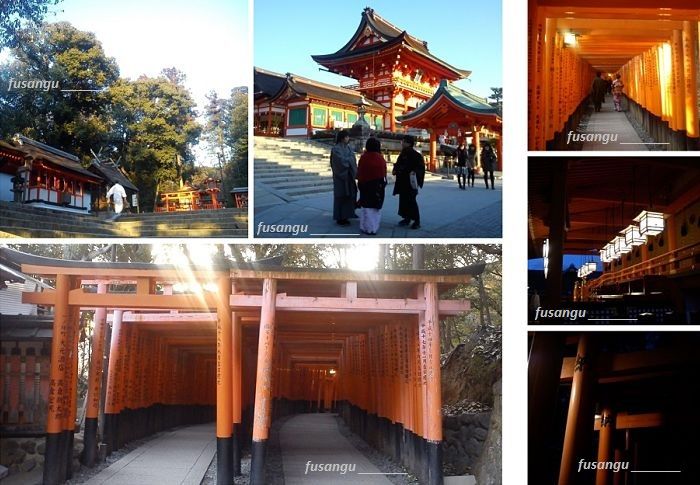
Variant: visit to Uji
You may change the programme so as to have a half day available to visit Uji, a pleasant small town rich in cultural heritage. Uji lies very close to Fushimi District; it is therefore very convenient to devote an entire day to Uji, Fushimi Inari Taisha and southern Higashiyama.
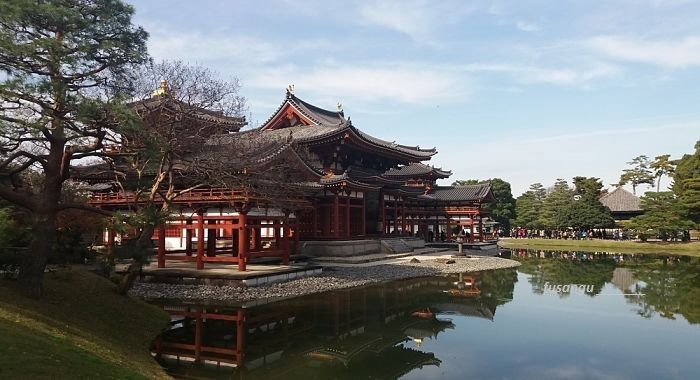
This itinerary is ideally part of a 10-day journey. Details in the following page:
Japan 10-day itinerary (full description of a ten-day trip to Japan; travel arrangements, practical information for a journey along the classic route)
Related articles:
Programmes of similar duration: 2,5 days | 3,5 days
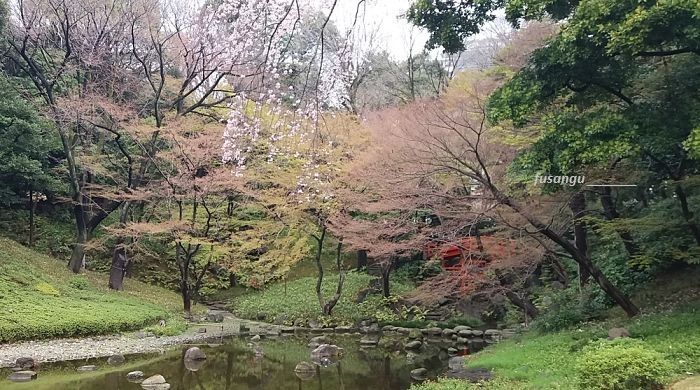
Visiting Tokyo in three days is not easy. The city is very large and there are many places to see and things to do. On top of that, learning how to get around requires some time.
It is therefore of utmost importance to prepare the visit as carefully as possible, having a clear image of what places should be visited, how to organise the itineraries, how to make use of the public transport system and where to stay.
Three days are not much time but if you carefully organise the visit you will have a satisfying experience.
The programme described hereafter offers a good introduction to the astonishing capital of Japan, from its historical heritage to its contemporary image.
The itinerary has been conceived as to minimise difficulties in getting around making transfers easy, short and inexpensive. As a consequence, each day is devoted to a relatively small area or to places efficiently connected to each other.
Given the premise, here is how we suggest you plan your visit:
-
Day 1: Northeast, Taito and Sumida districts (Ueno Park, National Museum of Tokyo, Asakusa area, Senso-Ji temple, Sky Tree Tower);
-
Day 2: City centre, Chiyoda and Bunkyo districts (Eastern Imperial Palace Gardens, Yasukuni Shrine, Koishikawa Koraku-En garden, Yushima Seido temple, Kanda area, electric town of Akihabara);
-
Day 3: West, Shibuya and Shinjuku districts (shopping area around Shibuya Station, Aoyama area, Omotesando, Meiji Shrine, Shinjuku-Gyoen Park, Tokyo Metropolitan Government Towers, Shinjuku Station area).
Day 1: Taito and Sumida
The first day is spent in Taito and Sumida districts. This is where you will have impressions of how Tokyo was before the war. The area covers much of what was previously called Shitamachi.
Though not much remains in the shapes of present day buildings, the urban dimension, the context and somehow the atmosphere are reminiscent of what Tokyo was before being flattened during the last year of World War II.
If you enjoy walking you can follow this programme by just getting around on foot. Otherwise, easy and fast rides are offered by the subway system (Ginza and Asakusa Line).
Morning
Ueno is a great place to start your journey in Tokyo. Beside being easy to reach from any part of the city as well as from Narita Airport, Ueno is also one of the places where you should find accommodation if you want to make things easy. Hotels and hostels in the area are not too expensive but they are easily fully booked (more about this point at the end of the page).
Ueno Park is a fascinating green area which was created at a time when Tokyo was imitating many aspects of Western urban planning. A few temples and shrines lie within the area. Among them not to be missed are the beautiful Bentendo and Toshogu Shrine, a glittering anticipation of the artistic masterpieces you may see if you choose to visit Nikko.
The beautiful park is also one of Tokyo’s favourite cherry blossom spots. Around end of March beginning of April the alleys are covered in clouds of white petals. Some trees of late blossoming varieties will please the latecomers.
Absolutely not to be missed out on is Tokyo National Museum, an outstanding collection of artworks which provides a unique opportunity to get to know the country’s ancient culture and art.
Even if you choose to visit only the main hall, we suggest you allot at least 3-4 hours.
Afternoon
A quick ride with the Ginza Line takes you to Asakusa Station. You can also get there on foot, even if the area you have to go through has not much to offer.
Asakusa is widely considered to be Tokyo’s traditional district. While you will not see old houses and vestiges of the past, the area retains the scale and the atmosphere of bygone times. Small restaurants, shops and family run businesses make for delightful views. What you see must be complemented by a good deal of imagination, possibly nurtured by some readings.
A must-see is the Senso-Ji, historic Buddhist temple. While this was completely destroyed during the fire bombings in 1945, the nearby Asakusa Shrine survived.
You can access Senso-Ji through Nakamise-dori, an alley along which you can find plenty of souvenir shops. Quality is variable but you can find many cheap items and ideas for gifts.
Nearby Hanayashiki amusement park would make for a journey into the past but time is too limited and you should postpone this visit to the evening.
After visiting Senso-Ji you can reach Sumida. Again, you can go there on foot or by subway. If you visit Tokyo during the cherry blossom we suggest you go on foot, so as to stroll in Sumida Park.
In Ryogoku, the area in Sumida just across the river, you can find Kokugikan, the country’s most celebrated sumo arena and Edo-Tokyo Museum, an amazing narration that will allow you to get to know Tokyo’s recent history.
Taking the Asakusa Line you can reach the Tokyo Sky Tree on top of which you can enjoy a commanding view of the gigantic conurbation of the capital of Japan.
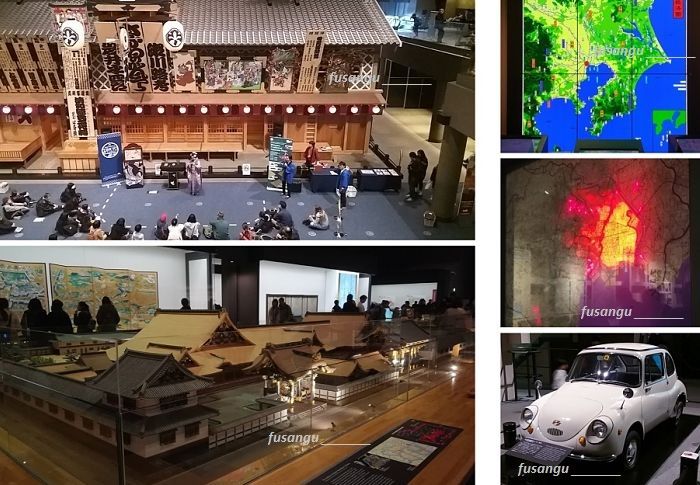
Other possible visits
It is unlikely that you will have time for more visits but if it is the case you may also pay a short visit to the Sword Museum or Yokoamicho Park. In the latter you can visit the Great Kanto Earthquake Museum as well as the Memorial for the Victims of the 1945 Bombings.
Before visiting Ueno you may have a walk through Yanaka, one of Tokyo’s traditional areas. Again, time is limited so you should be careful in your decisions.
In the evening: 4 options
In the evening there is plenty to see and do. We suggest you choose among the following places and activities:
-
Akihabara, the so-called “electric city” is a must-see for anyone fond of anime, manga, video and computer games and contemporary culture;
-
Kodokan, the world sumo headquarters are open to the public. You can watch or even attend the training. The nearby Tokyo Domu is an entertainment complex;
-
Rikugi-En, in Bunkyo, one of Tokyo’s most important and beautiful gardens, it is open to the public till the evening during the cherry blossom season;
-
Meguro-gawa, a narrow river lined with cherry trees, lit during the blossom season.
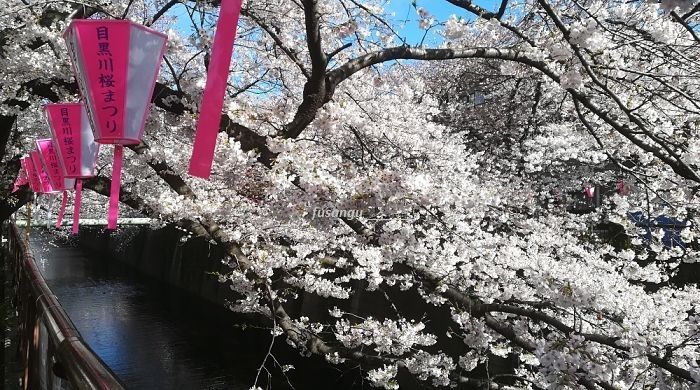
Variant: Yanaka
Traces of the ancient city are even more evident in Yanaka, a small and quaint neighbourhood to the east of Ueno Park. The area is easily accessed on foot from Nippori Station (served by Yamanote JR Line).
A large cemetery where notable and common people rest is in the centre of Yanaka. Old temples and shrines surround it. A visit to Yanaka should also include Yanaka-Ginza, a narrow alley where you can find picturesque shops, tiny restaurants and street food stalls.
If you choose to visit Yanaka you will necessarily have to drop other points of interest from your programme.
A possible itinerary passes through these areas:
-
1) Yanaka;
-
2) Ueno;
-
3) Asakusa;
-
4) Ryogoku.
There will not be enough time to visit museums in Ryogoku though.
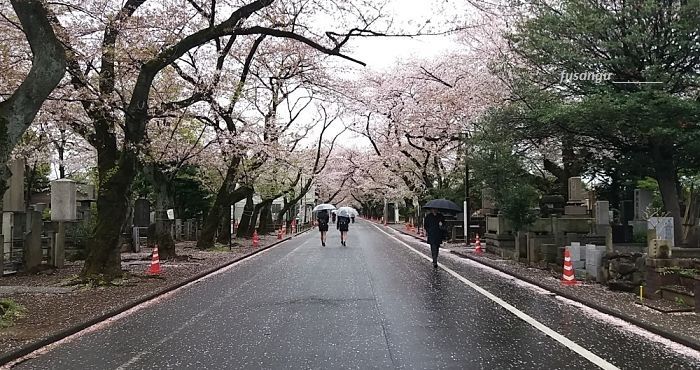
Day 2: Chiyoda, Bunkyo
The second day programme requires covering larger distances. The visit focuses on Chiyoda and Bunkyo districts, areas in the centre of Tokyo.
Morning
Tokyo Station is an ideal starting point for this itinerary. The surrounding Marunouchi is the financial centre of the city.
With a short walk you can reach the Eastern Gardens of the Imperial Palace and then see the moats and massive poligonal walls surrounding the residence of the sovereign.
Very close to the Imperial Palace are Chidorigafuchi, amazing scenery during cherry blossom season, and Yasukuni Shrine.
Yasukuni Shrine is a shinto shrine where the Japanese venerate the spirits of those who gave their life for the country in the wars. It was built in the aftermath of the Boshin War, the civil war which marked the end of the Feudal era.
Inside the shrine grounds is Yushukan, a museum which portrays controversial points of view regarding the recent history of Japan. While this narrative is vehemently rejected in countries like China and Korea who suffered under Japan’s rule, visiting the museum and looking at things from a different perspective is certainly a valuable experience.
Afternoon
After visiting Yasukuni Shrine you can reach Ichigawa Station on foot. Here you can choose among three options:
-
1) Visit to Bunkyo e Kanda;
-
2) Visitto Shinjuku;
-
3) A brief excursion to Kamakura.
1): Visit to Bunkyo e Kanda
From Ichigawa Station you can reach Iidabashi Station by train (JR Chuo Line). From this station you can walk to Koishikawa Koraku-En, a magnificent landscape garden.
The garden is the starting point of an interesting path through Bunkyo and Kanda, areas full of temples and sightseeing places, which nevertheless is usually neglected by foreign tourists. These are the main places to visit:
-
Yushima Seido, historic Confucian temple;
-
Kanda Shrine, one of Tokyo’s most revered shinto shrines;
-
Ochanomizu and Jimbocho, two residential areas famous for a large presence of bookshops and musical instruments shops. Nearby are some of Tokyo's major universities.
If you like walking through the ordinary city you may want to reach Ueno or Akihabara.
The area is well served by the mass transit system, so you are never too far from a subway station.
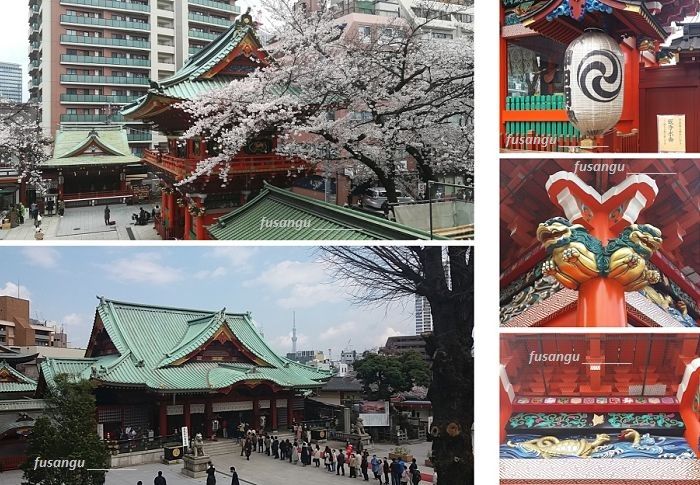
2) Visit to Shinjuku
As you move from Chiyoda to Shinjuku you can explore Yotsuya, a residential and commercial area. Along the path leading to Shinjuku Station you can visit a few museums:
-
1) Fire Museum;
-
2) Tokyo Toy Museum;
-
3) Samurai Museum.
In the evening you can plunge into the noise of lights, sounds and temptations of Shinjuku, a place of contrasts, one of the symbols of modern Japan.
If you just want to see the commercial area around Shinjuku Station, in less than 15 minutes you can reach it by taking a train on the Chuo Line. We suggest you do not miss out on the Shinjuku-Gyoen, a vast park, particularly beautiful in spring and autumn.
3) Short trip to Kamakura
If you have done with Chiyoda by 10:30 it is worth considering a short day trip to Kamakura. The time being very limited, you have to focus on a very limited area of the locality.
We suggest that you choose one of the following options:
-
1) Kotoku-In and Hase-dera;
-
2) Zen temples in Kita-Kamakura, a locale just north of Kamakura.
Day 3: Bunkyo, Shibuya, Harajuku, Shinjuku
The third and last day focuses on the western part of Tokyo, the districts of the modern and contemporary city.
Morning
A perfect start is a visit to Rikugi-En, a traditional garden of exquisite beauty. Every scene is a depiction of classical poetry themes. This is the kind of places that can be best appreciated having prior knowledge.
Rikugi-En can be reached on foot from Komagome Station. From here you can move to the next destination, Shibuya, the young city. Similarly to Shinjuku, the station here is the centre of the action and sightseeing. All around the station are shopping malls, some of which may easily entrap you for a day.
If you manage, try to get out by 12:00, not after paying your respects to the statue of Hachiko.
From Shibuya you can reach the next destination, Meji Shrine by train. We suggest you walk and go through Aoyama, an upscale residential area full of nice coffee shops.
Once you reach Omotesando, you have to turn left and go along the large boulevard. This is one of Tokyo’s luxury districts.
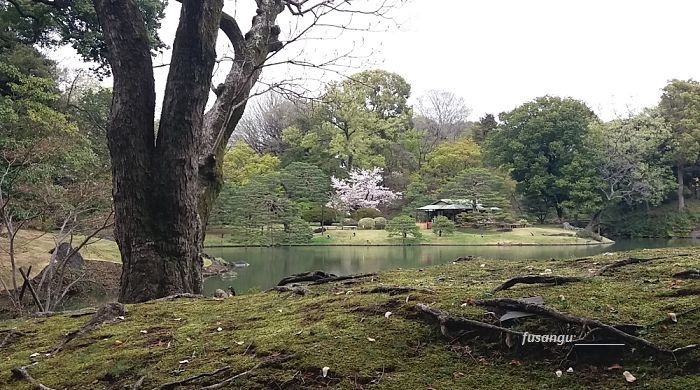
Afternoon
If you want to make things easy and visit only one place between Shibuya and Shinjuku, you will mostly choose Meiji Shrine and the beautiful park surrounding it.
If you have little time opt for Shinjuku-Gyoen, a large park with Japanese and western style gardens. This is most interesting in March and April, when you can see many varieties of plum and cherry trees. A lot of early and late flowering varieties can be found here.
If you want to see the city from the top of a skyscraper but you are not willing to pay the exorbitant amount request at the Tokyo Sky Tree, the Metropolitan Government Towers are for you.
Finally, it is time to explore the surroundings of Shinjuku Station, one of the most vibrant and extravagant areas of Tokyo and the whole nation.
Dining options are virtually limitless. A good choice is to dine in an izakaya, a typical small and cheap eatery where you sit on the floor and enjoy simple cheap dishes and drink beer.
Variants
If you need to buy electronic devices of any kind, you can head to Ikebukuro. Around the station (easily reachable with Yamanote Line), you can find lots of departement stores.
If you are fond of traditional culture and arts do not miss out on a visit to Nezu Museum, an outstanding collection of works of at from Japan and other East Asian countries.
Three days in Tokyo: how to get around
If you want to make things easy and save time and money, you ought to choose well the place where to stay. Great options are Ueno, Asakusa and Shinjuku. Second choices are Sumida and Akasaka. Refer to the next paragraph for more details.
Urban railway and subway
There are no tourist passes allowing you to use both the JR urban lines and the metro lines. Furthermore, you should take into account that Tokyo’s subway is made of two separately managed networks, the larger Tokyo Metoro and Toei subway system.
The itinerary described in this page has been conceived as to simplify the organisation of the trip and minimise travel time and difficulties.
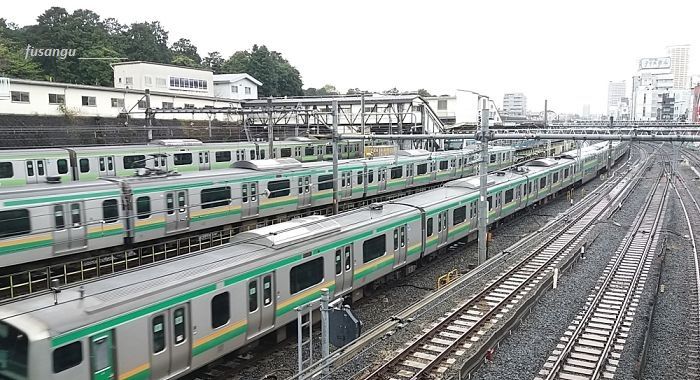
Day 1: how to get around in Ueno, Asakusa and Ryogoku
During the first day visits are limited to Ueno, Asakusa and Ryogoku. The three neighbourhood are adjacent to each other and distances are very limited. You may choose to employ one of the following ways to move:
-
By subway: Ginza Line between Ueno and Asakusa; on foot between Asakusa and Ryogoku;
-
By train: Sobu Line between Akihabara (which you can reach on foot from Ueno) and Ryogoku.
The second solution involves a stop in Akihabara, a nice place full of restaurants and shops. Along the way from Ueno you can also visit Ameyoko market and a few craftsmen’s shops.
Day 2: how to get around in Chiyoda and Bunkyo
During the second day sightseeing takes place within Chiyoda and Bunkyo areas. The two districs are adjacent to each other and distances are quite limited. You may choose to employ one of the following ways to move:
-
By subway: Marunouchi and Shinjuku lines between the centre and Kudanshita Station, located a few steps aways from Yasukuni Shrine; Namboku and Oedo, between the shrine and Kanda or Bunkyo;
-
By train: Chuo Line between Ichigawa (not far from Yasukuni Shrine) and Ochanomizu (which is the place from which you can access Bunkyo).
Day 3: how to get around in Shinjuku
On the third day you have to move between Shibuya and Shinjuku. The following options are available:
-
By subway: Fukutoshin Line between Shibuya and Higashi-shinjuku stations;
-
In treno: Yamanote Line.
The first option requires you to walk a little.
As you can see all transfer make use of either the subway or the urban railway networks. It is not necessary to get around by bus, which would also be slower and more difficult.
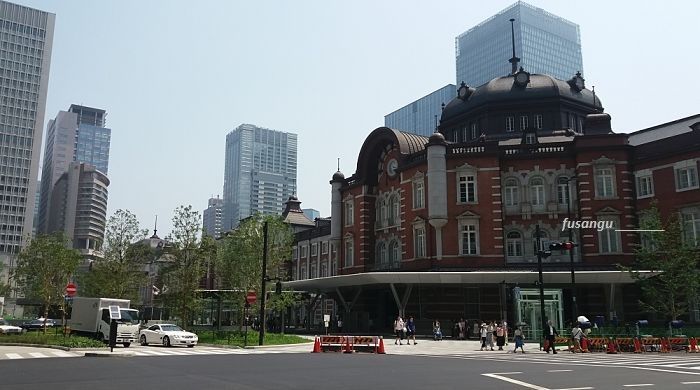
Three days in Tokyo: where to stay
The best places to stay if you intend to follow this itinerary are:
-
1) Ueno (or nearby Asakusa), neighbourhood easily accessible from anywhere, including Narita Airport. There is an ample variety of accommodation solutions, ranging from hostels to modern and western-style hotels. A sizeable number of cheap and mid-range ryokan are located between Ueno and Asakusa;
-
2) Shinjuku, the nightlife centre. Here most hotels are modern and sleek western-style structures in high-rise buildings, very few have a touch of Japanese aesthetics;
-
3) Chiyoda, near Tokyo Station or Kanda Station, the centre of the centre of the city. Many of the city’s most luxurious hotels can be found in this area. Mid-range hotels and good quality hostels are found near Nipponbashi (north-east of the station).
These three districts are well connected to any part of the cities as they are served by the circular Yamanote Line as well as by a few of subway lines.
If you are still unsure as to how to make choices, you may refer to the following criteria:
-
Saving money: in general among the areas mentioned here, Asakusa is the first choice when it comes to looking for cheap hotels. Many hostels are located near Asakusa Station. A few mid-range hotels are located between Asakusa and Ueno. If you seek a good price-quality ratio and you do not mind getting a little away from the centre, focus your search on Sumida. The quarter has not much to offer to a tourist but it is quiet, clean and very well connected to the city centre;
-
Easiness of transfers: all three areas are well connected and easy to reach from any areas of Tokyo and the airports. If we were to make a choice, we would say that Ueno is the best choice in this regard;
-
Side-trips: from Tokyo it is possible to reach many interesting tourist destinations of outstanding natural beauty and cultural significance, such as Nikko, Kamakura, Hakone and the Five Lake Region. All three areas mentioned here are easy starting point of day excursions.
If you choose to visit Nikko, taking into account that you ought to start your trip early in the morning, Asakusa is definitely the best choice. Tobu trains to Nikko leave from Asakusa Station. If you want to visit Hakone or Kawagoe, Shinjuku provides the best base. Tokyo Station is where you can start your trip to Kamakura;
-
Nightlife: Asakusa is a quiet neighbourhood. You would like it for a day or two but you might find it a bit boring later. Shinjuku is the place to stay if you want to explore Tokyo’s night- Chiyoda caters only in terms of high-end restaurants and cocktail bars.
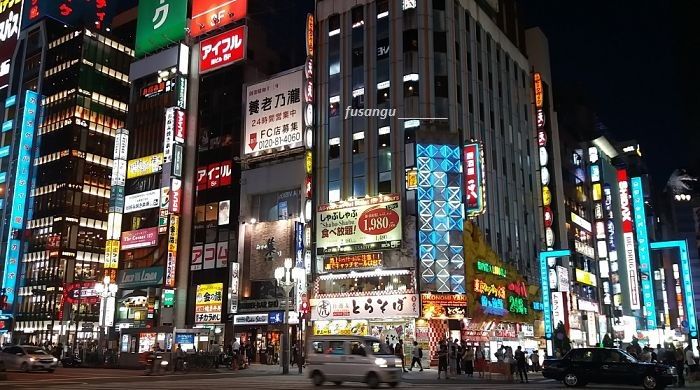
This programme is ideally part of our recommended Japan 10-day itinerary.
Related articles:
Tokyo 2,5-day itinerary | Tokyo 3,5-day itinerary
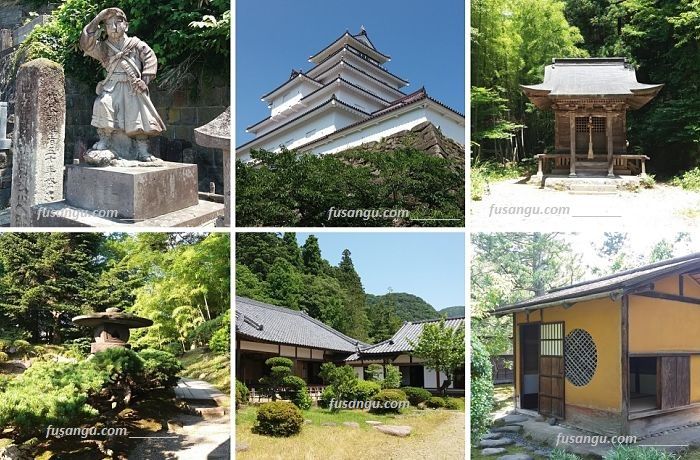
Aizu Wakamatsu is a small-size city located in the Tohoku region. It has a special place in Japan’s modern history as it is a symbol of the heroic final struggle for survival of the samurai class.
Aizu Wakamatsu is mysteriously still relatively unknown to most foreigners who choose to visit Japan. The city is well worth a visit as it offers a fair range of attractions and cultural sites. There are many things to do and places to see in the city and its surroundings. However it is its history that will inevitably fascinate you.
Travelling by fast and local trains you can reach it from Tokyo in a little more than 3 hours. It makes no sense in our opinion to try and visit it on a one-day excursion. You should at least spend a night in Aizu Wakamatsu. This in itself is one of the attractions of the city. Hotels and a few traditional inns are good value for money.
Aizu Wakamatsu can also make for an easy destination to add into the programme of a journey in Tohoku. Those who have little time can easily add combine it to a visit to Nikko.
How to plan a visit to Aizu Wakamatsu
A very convenient bus line links all major sightseeing spots in Aizu Wakamatsu. The buses depart from the main raiway station (Aizu-Wakamatsu JR). It could not be easier to arrange a one-day visit in the city.
Though one day is enough to visit the majority of the city’s cultural and historical places, you will typically another day if you are into history and want a more in-depth experience.
You might also choose to stay longer to have a chance to visit the surroundings. Getting around by public transport is not very convenient and therefore it is better to resort to taxis.
Itinerary
Take a tourist bus in the clockwise direction from Aizu Wakamatsu station There are a number of destinations along the way. These are the main ones:
-
Iimoriyama, a small hill to the east of the centre of Aizu-Wakamatsu. On the hill are the graves of the Byakkotai, the young fighters who committed ritual suicide as the the defeat of the samurai class seemed inevitable;
-
Aizu Bukeyashiki Museum, a large Edo-period residential complex. The house has 38 rooms, many of which beautifully decorated. The site comprises a mill, a tea house and other auxiliary buildings. A number of displays sheds light on how an aristocratic family of samurai lineage would live. Well-organised and taken care of, the site offers a few hands-on activities, a souvenir shop and a restaurant;
-
Oyaku-En Garden, a renowned Muromachi-period strolling garden. At the centre is a large pond, deemed sacred, and a tea house. Flowers bloom all year round and seasonal changes in colour and shape make it a never-ending source of surprise. Besides you can see a medicinal herb garden;
-
Tsuruga Castle, a beautiful military architecture surrounded by a large park and an elaborate defensive moat. Its red roof is unique in Japan. Built nearly 630 years ago, it was destroyed after the Boshin War and became a symbol of the strenuous fight of the samurai class. The current structure is a reconstruction concluded in 1965. Inside its core building is a museum about the history of Aizu-Wakamatsu. The great engineering fear aimed to revive the traditional construction methods.

This programme is ideally an addition to our recommended Japan 10-day itinerary.
Page 7 of 8
